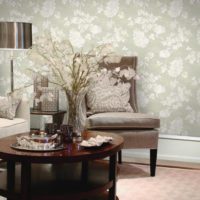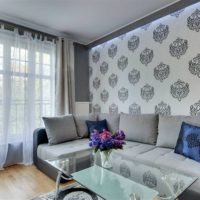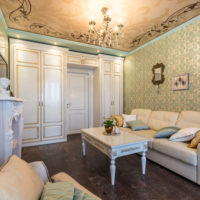Wallpaper for the living room: design and texture, selection criteria
Not so long ago there were no problems with the choice of finishing materials, including wallpaper for the living room, there were few of them, all paper, with a small offer of colors. Today it is difficult to dwell on one thing, when they start another repair - a huge assortment of drawings, textures and materials. Even experienced designers often find it difficult to browse catalogs of imported and domestic goods. In order for the interior design to turn out not only original, but also harmonious, it is important to take into account the recommendations of specialists.

The choice of wallpaper will ultimately affect the final image of the living room.
Content
Varieties of wallpaper in the guest room and their characteristics
Where to start when you need to choose a wallpaper for an exclusive living room interior? Fashionable design trends determine the direction for the next 5 years, when specialized international exhibitions are held. Up to 1000 varieties can be seen on display. There are even luxury wallpapers with hand-painted, precious splashes or gold and silver plating. In most cases, only general trends will be reflected in catalogs for the mass consumer.

The choice of wallpaper should be approached very responsibly, because this is not decor and textiles, which can be easily replaced in case of a rash purchase
Roll wallpaper is the simplest kind of wall decoration. Regardless of preferences for materials, shades and colors, choose meaningfully what wallpaper should be in the interior of your living room.
Paper
The most popular, affordable and easy-to-use cladding, including guest rooms. They are offered in the largest assortment - it is easy to pick up for any design style, from country to modern.

Paper wallpapers are much cheaper than all other types.
Most of the offers are available for self-pasting of walls, since they do not require joining of seams and fitting according to the drawing. This includes varieties such as vinyl and washable wallpapers, silk screen printing and volume printing.
Photowall-paper
Photowall-paper - a kind of usual paper rolls. This type of finish is again at the peak of popularity. Designers suggest using them in a new quality - as wallpapers expanding the space in the interior. They are designed for one wall, represented by a single image - a city panorama or landscape, spatial illusion or some interesting 3D object.

The choice of photo wallpaper is simply huge - city landscapes, plants, children's themes, starry sky and anything else
These compact wallpapers can be an advantage in the interior of a living room when you need to quickly complete repairs to a specific event, hiding the flaws of one wall. Often used on an accent wall, behind a backdrop of upholstered furniture or in a small wall.
Wooden
Wooden or veneered wallpapers are usually applied on a paper or non-woven backing. This is a designer favorite, so it will be used in the coming years. The surface is in the form of a thin wood cut beautiful texture of valuable species found in remote corners of the planet.
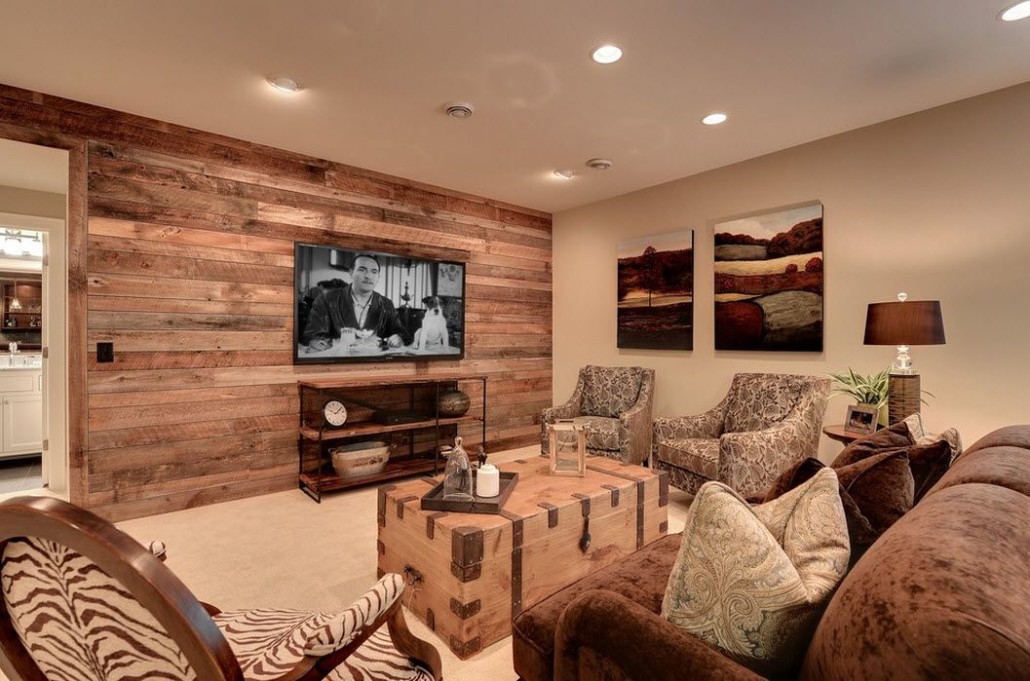
Wooden wallpaper in the interior of the living room of a country house
Veneered wallpaper in the interior of a classic living room is a traditional choice, thanks to which the room finds a warm aura of hospitality. They relate to eco-materials - an elite wall cladding with the advantages of natural wood (in a thin section). The lining, decorative panels and eco-veneer are also part of the decor with the effect of lining the walls with wood.
Eco wallpaper
Eco-wallpaper is a new format for finishing materials on a natural basis. They are most favorable for health, but least in demand because of their price and insufficient popularization. They are also produced on the basis of paper or non-woven fabric (fibrous non-woven textiles) for the original design of wallpaper in the living room. As the surface layer, vegetable fibers are used - jute, algae, hemp, reed, bamboo.

Bamboo wallpapers are ideal for oriental style, but in a modern interior they will become a highlight
Hypoallergenic wall decoration, pleasant to touch, does not contain caustic chemical dyes. All information about their application is presented on rolls, but it is important to purchase all the wallpaper from one batch, so that the texture does not differ. Pleasant to the touch varieties that came from Asia, with high sound absorption:
- cork (based on spongy bark, afraid of moisture, can be vacuumed);
- bamboo wallpapers (water-repellent, washable, slightly tinted with natural shades).
Fabric
Textile wallpaper is the ancestor of all rolled materials, since it was originally invented to drape and paste the walls with fabric. It was a very beautiful, but expensive finish with a direct relation to the concept of “wallpaper” (the walls were “draped” with curtains). Today it is a lightweight fabric adapted for gluing walls, but the texture is much like the usual silk and velvet, linen and satin, tapestry and jacquard (matte pattern on a glossy basis).

Fabric wallpapers add sophistication and luxury to the living room.
Wallpaper for painting
Wallpaper for painting - non-woven and glass, which after careful pasting will survive several repairs. They can be repainted several times, but gradually the three-dimensional drawing will be filled with paint. They also apply to environmentally friendly materials. Incompatible with pet claws. When applied, they are not impregnated with glue, processing only the base.

Cullets are very strong and durable, are not afraid of moisture and can be repainted several times
Beautiful textured wallpaper in the living room in the interior of any style. They are hypoallergenic, they do not start mold, fungus and other pathogenic microflora, which provides clean air in the house.
Metallized
Metallized or foil - rare wallpaper for the living room in the interior of apartments and private houses. They perfectly reflect any radiation, therefore they are recommended in apartments located in close proximity to the transmitting points of telecommunications. Noble shimmer, reflecting light, making the room not on the north side lighter, saving power.

Metallic wallpapers are used by designers to create an exclusive interior. Produced with a pattern and volumetric printing in silver, copper or gold
Favorite design move when it is required to design a modern interior in a special way. They are released on a paper substrate, so there is no difficulty in pasting the walls. The catalogs offer smooth and textured wallpapers, with perforation and volume printing. Metallic shades - in gold and silver, copper and bronze. But the foil does not breathe, and the damaged texture can not be restored - buy with a margin.
Liquid
A kind of coating that has little in common with rolled materials is “liquid wallpaper”. Rather, it is a kind of decorative plaster based on dye and cellulose fibers with textured impregnations.

Liquid wallpaper does not fade from sunlight for a long time
Moisture resistant
Washable and moisture-proof wallpapers are used in a studio apartment or living room combined with a kitchen or other room.

Washable non-woven wallpaper
As it has already become clear, each variety has its advantages and disadvantages. They have to be guided by when buying wallpapers that expand the space in the interior of the living room, give more light, protect from high humidity or for another practical purpose.
How to choose wallpaper for your interior?
A huge variety should not confuse potential buyers, if you know the rules of choice.
The “golden rule” of design: Under dark furniture - a light background of the wall, under the light - dark. For plain upholstery - wallpaper with a large pattern, in the interior of the living room with plain walls - patterned textile. The color of the vertical surfaces should be in harmony with the whole decor, ceiling and floor.
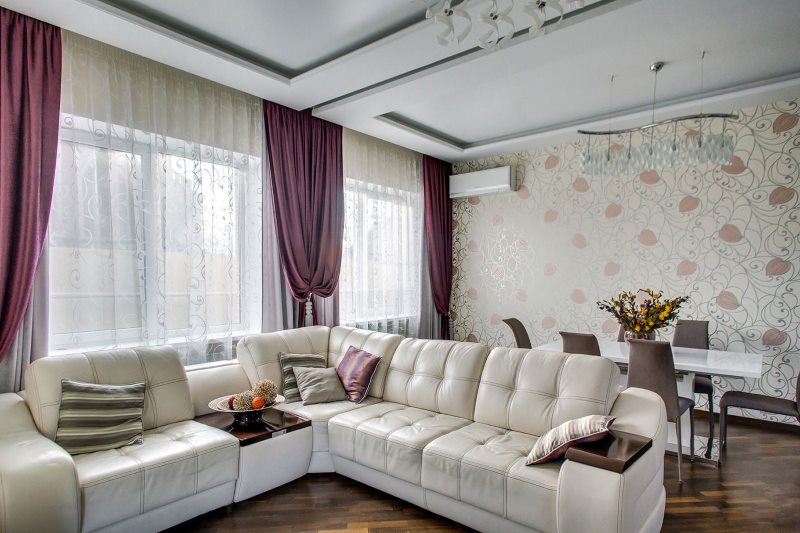
Light wallpapers will add a fad to the living room and add lightness, which is especially important when the windows face north
The choice of the shade of the walls depends on many factors:
- design style;
- the degree of illumination of the room and the type of fixtures;
- shades of wood furniture and joinery;
- color of floor and ceiling;
- textile pattern (curtains, upholstery, bedspreads, etc.).
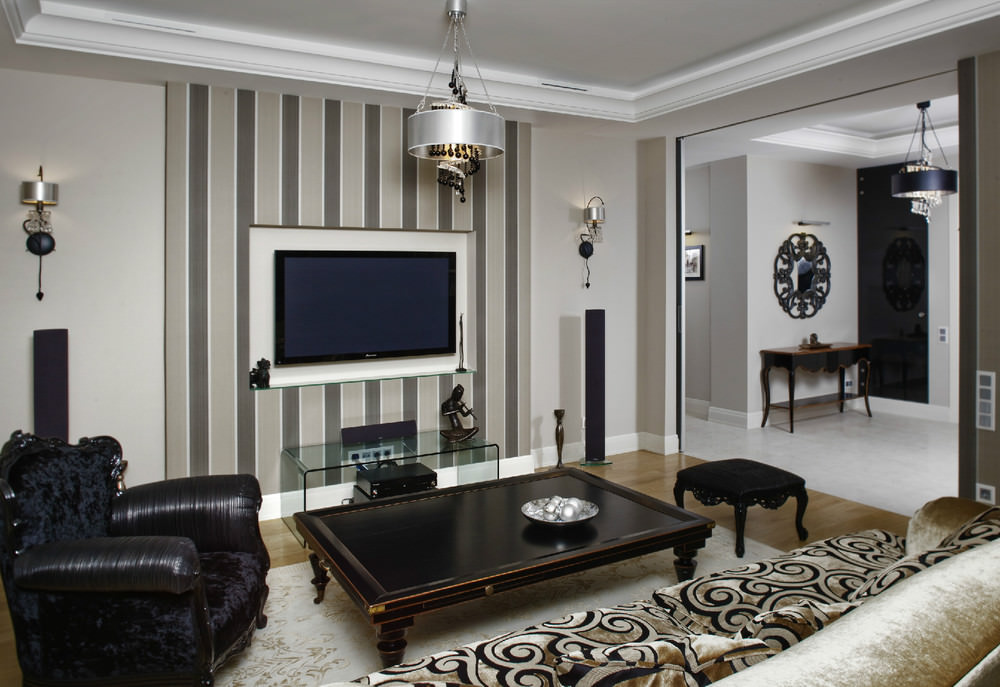
Dark wallpapers are suitable for highlighting any part of the wall, for example, above a fireplace or behind a TV
The room on the north side does not buy dark finishes or cold gamut rolls. Preferred walls are light, warm, white, milky or beige. Accordingly, tulle is also selected, it is better not to use dense multilayer curtains. Gray and green wallpapers are recommended on the east and west sides.
Tip. If you want to use the design ideas of black wallpaper for the living room, experts recommend buying glossy or with a jacquard effect. But it is better to paste them on an accent wall or in a niche, as a background for expensive exhibits or antiques, like a velvet jewelry box.
In a small room, a motley large pattern is undesirable; it splits the space. If this is a large format ornament, then it is better without contrasting colors - a game of texture within the same color. The noble game of gloss and matte texture in jacquard wallpaper will make any living room design more stylish, elegant and spectacular, as in the photo.

Jacquard wallpaper in the interior of the living room in a classic style
Under the minimalist interior, they choose the finish without a complicated pattern. It is better to replace the expressive ornament with a simple design that imitates the textured plaster. This will visually expand the living room and create a feeling of fullness of light and clean air.
Tip: Make more use of the classic colors, do not forget that the vertical strip “lifts” the low ceilings, the horizontal strip pushes the walls, the diagonal strip zones the space well.

Highlighting one wall with contrasting wallpaper will visually fix the geometry of space - “raise” the ceiling or “push” the walls
It is better to paste a small room with an end room without a window on the wall murals that “dissolve” the wall. A panorama that opens the door to city blocks or to a forest lawn is the easiest way to transform a limited space.
Attention! Black color absorbs the space, the ceilings seem to lower and “crush”! Therefore, it is better not to rush with an extravagant choice, choosing wallpaper for the ceiling.

Walls with black wallpapers draw attention to other interior items
For large areas there are no special restrictions, the main thing is that there is no feeling of cold and emptiness. Equally important is the stylistic conformity and the feeling of a lived-in space. It is not desirable that everything be white or the color of the furniture merges with the walls.
Designer's tip. Often, when choosing the color of the walls, they are guided by their personal preferences - only their favorite color.As a result, bright red, raspberry, aquamarine or violet color tires, depresses the psyche and becomes annoying. The neutral palette, on the contrary, remains desirable, it does not cease to be “beloved” even after many years.
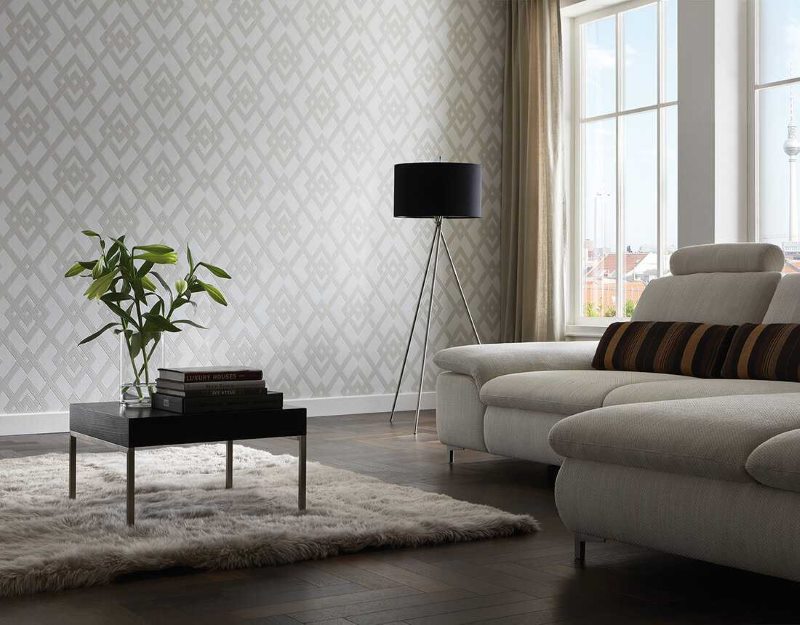
If the living room has a dark floor, it is better to choose light wallpapers
The secrets of combining patterns and textures
The simplest way to zoning a living room is a combination of different wallpapers in one room. The completion of the interior design, harmony and an organic combination of all elements will depend on their selection. For example, horizontal stripes at the ceiling visually expand the space of the room, regardless of the main finish.

The classic technique of combining wallpaper - selecting one wall
In order for different wallpapers to harmonize, they must have something in common:
- surface material;
- texture;
- the color of the base or pattern;
- image method (graphic, geometry, floral ornament, abstraction);
- stylistic community.

Ideally, you need to find wallpaper with a pattern that matches furniture and textiles
2 finishes combine well when combined with a strip. It is easy to pick up rolls of different textures in one gamut. For example, if some have a light floral ornament, others are just a small linear pattern. A good example where companion wallpapers are presented in the interior of the living room with a strip.
It is rarely possible to pick up a wallpaper for the coloring of upholstered furniture. This option will look harmonious in one case - do not put chairs or a sofa close to the walls. You can place them in an islet in the center of the living room or set them backs to the windows in the bay window, opposite curtains and curtains.

Often, a change in the primary color is used, for example, a white ornament on a gray background, and the opposite is dark on light
Coating walls that mimic the wood texture, it is undesirable to duplicate furniture, especially if the floors are also wood. In this case, everything will look like inside a wooden box, losing lightness and elegance.
If made with a predominance of woody texture, as in the interior of the living room photo, but it turned out unsuccessfully, do not rush to redo everything. Try to make everything easier by:
- glass shelves;
- light textile;
- modular paintings;
- light carpet on the floor with imitation fur covering most of the floor.
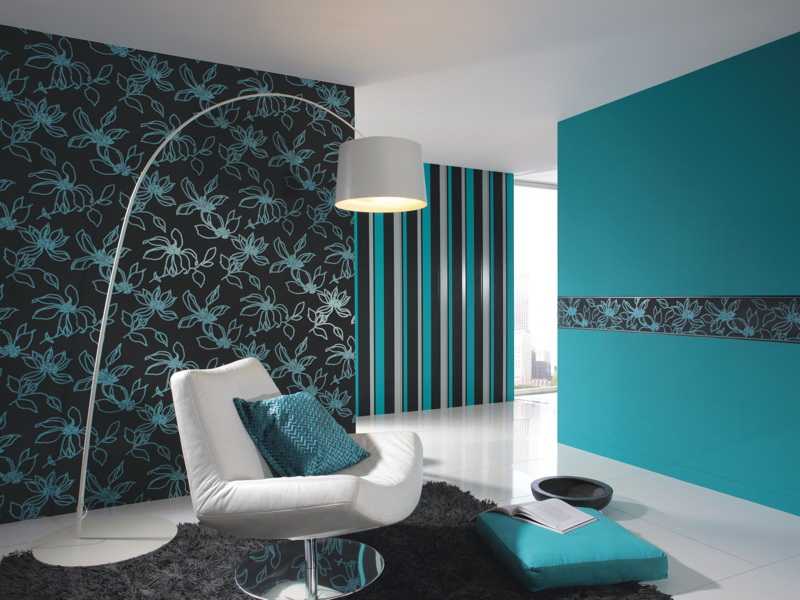
The combination of three types of wallpaper in one living room
Animal print also requires a thoughtful approach. A lot of “leopard” or “zebra” on the walls looks vulgar. Part of the wallpaper during the next repair can be left on the accent wall, the remaining surfaces can be decorated with textured plaster or painting.
Important! Mirrors should not be placed opposite the colorful picture of the walls - there will be twice as much “rowaniness”.
Sometimes other inserts are used for wall decor:
| 1. | Posters and Posters | For the urban interior, for the design of the "fan lounge". |
| 2. | Large photos | Insertions - the image of actors, singers, printed by their industrial printer their successful photographs. |
| 3. | Mosaic panels of broken tiles, mirrors and glass | A great solution for the dining area in the living room combined with the kitchen. |
| 4. | Geographic Maps | Designer's reception in the lounge of an avid traveler - above the recreation area. |
| 5. | Collages from the remains of wallpaper | On an accent wall, the theme should correspond to the chosen style. |
| 6. | Paper patchwork | Design only one wall, the colors can be varied, but the intensity is the same (better pale fragments). |
| 7. | DIY wall painting | It is used as an independent object or if expensive wallpapers were not enough - filling the wall with a picture. |

Posters instead of wallpaper

In modern interiors, ethnic motifs are often used in the spirit of African, Indian or Asian dwellings.
Author's painting is done on the prepared surface. Choose the theme of the picture, photo wallpaper and other inserts carefully. A sense of proportion is especially required when portraying city blocks, a jungle or a forest.The living room with an imitation of the library looks “intelligent”, but don’t do it on all the walls - this is too much. It is better to draw one surface this way.
Exactly the same wish applies to the choice of wallpaper with imitation of columns, pilasters, arches and other architectural techniques in the design of the living room.

The luxury of the living room, the walls of which are decorated with chic wallpaper with gilding and decorating details in the same style

Eclectic living room with dark wallpaper and lots of interesting decorating items.
An interesting design technique is rarely used by beginners in interior design. However, contrasting inserts, designed according to the principle of shallow niches in the wall, if they are absent, are an excellent solution for shelves and figurines, antiques or equipment.
For more original solutions with photo wallpaper, imitation of stone and brick, a combination of colors, companions, see our photo gallery. Choose the most appropriate example for inspiration.
Video on how to combine wallpaper





